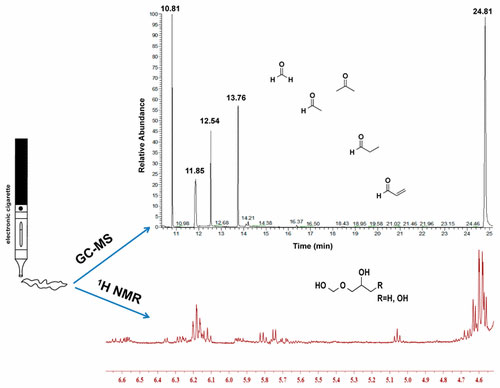Since they hit the market in 2004, electronic cigarettes have had their share of both detractors and advocates. Many people believe that they are healthier than cigarettes, but others say that the effects of e-cigarette vapors are largely unknown.
Medical organizations have generally taken a cautious approach and do not specifically recommend e-cigarettes for stopping smoking or as a healthier alternative to smoking.
One area of concern is the amount of aldehydes present in e-cigarette smoke. These aldehydes are present in tobacco cigarettes in larger quantities than in e-cigarettes, but the levels in e-cigarettes are still not known. Additionally, the amount that is considered dangerous for cardio vascular disease (CVD) is a topic of debate. Some studies have shown that even small amounts of certain aldehydes can lead to progression of CVD.
Researchers from the University of Louisville’s Tobacco Regulation and Addiction Center conducted quantitative analyses of both older (first generation) and newer-model e-cigarette cartridges using a variety of flavors. They used a new method for trapping reactive carbonyls that are then subsequently stabilized using an oximation reaction. They found that newer devices produced more harmful aldehydes than first generation e-cigarettes. Their work appears in ACS Omega.
E-cigarettes cartridges contain battery-powered coils that serve to heat and vaporize e-Liquid. Based on this study, the amount of reactive aldehydes in e-cigarette vapor are largely due to the cartridge’s battery power. The higher the battery power, the higher the aldehyde levels. While e-cigarette aerosols contain aldehydes that are known to contribute to CVD, the exact levels have not been definitively determined largely because of the difficulties associated with trapping and studying reactive aldehydes.
New models, or ‘next gen’, e-cigarettes have a higher battery power than older ones. Furthermore, older models have a fixed battery output (4.6 W) while the next gen ones have variable output (9.1 W, 11.7 W, 14.7 W, 16.6 W). The authors wanted to look at this next gen of e-cigarettes to quantitatively determine aldehyde levels as well as determine if e-Liquid flavor makes a difference in aldehyde formation. In order to do this, they took into account the formation of hemiacetals from aldehydes, something that prior studies did not address.
The aldehydes that are of greatest concern are acetaldehyde, acrolein, and formaldehyde. Acrolein, in particular, has been shown to advance CVD, even when a person is exposed to low levels. Formaldehyde has also been associated with CVD in low concentrations.
E-Liquids are usually comprised of glycerin and propylene glycol along with a flavor additive. Glycerin, when heated, predominantly forms acrolein and formaldehyde, while propylene glycol predominantly forms acetone and acetaldehyde. Certain flavor additives have shown enhanced aldehyde formation, as well.
Ogunwale et al. used a microreactor-capture approach that they had previously developed to obtain an accurate look at aldehyde levels in e-cigarette vapor. This method employs a 4-(2-aminooxyethyl)-morpholin-4-ium chloride (AMAH) coating on a silicon base. Aldehydes selectively react with AMAH to form an oxime, which is more stable and easier to study than an aldehyde.
Aerosols were generated using a cigarette-smoking robot and were collected in Tedlar bags. The robot allowed for control over puff duration, puff volume, and puff frequency. The aerosols flowed through the microreactors from the bags using an evacuation process and then reacted with AMAH. The AMAH oxime compound was neutralized to form an AMA adduct that was then studied using gas chromatography.
Both the first generation and next generation e-cigarettes produced some amount of acetaldehyde, acrolein, and formaldehyde, but acealdehyde and formaldehyde were in higher concentrations than acrolein. All of the aldehydes were present in lower concentrations than what is found in cigarette smoke using Health Canada Intense Puffing Regime. Notably, the next-generation e-cigarettes, which have a tank-type atomizer, produced higher levels of aldehydes and acetone. The authors attribute this to the higher battery output.
To understand the puffing topology, Ogunwale et al., used 60-mL syringes to manually vary puff duration and volume to more accurately replicate real-life usage. Puffing duration and the particular flavor contributed to the formation of reactive aldehydes, although these factors played a smaller role than battery output in the amount of aldehydes present. If puffing duration was around 4.0 seconds/puff, more aldehydes were present compared to shorter or longer puffing. The average user puffs for 3.5 to 4.3 seconds.
Finally, Ogunwale et al. used 1H NMR to detect and quantify the presence of hemiacetals formed from aldehydes. They found that hemiacetals did not form in any of the first-generation e-cigarettes flavors, and they did not form in three of the next-generation flavors tested. Only one flavor that was tested formed hemiacetals within a battery output that was within the range of normal use.
This study provides valuable information on the safety of e-cigarettes. In general, the higher the battery output, the higher the aldehyde levels in the vapor. Certain aldehydes, such as acrolein, acetaldehyde, and formaldehyde, have been shown to contribute to CVD even in low levels. All of the e-cigarettes tested in this study had some amount of these aldehydes present.



Comments are closed, but trackbacks and pingbacks are open.